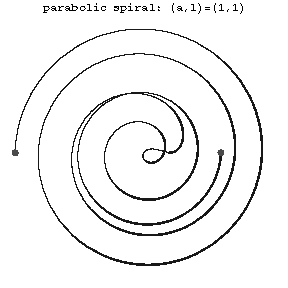Difference between revisions of "Parabolic spiral"
From Encyclopedia of Mathematics
(Importing text file) |
(gather refs) |
||
| (One intermediate revision by one other user not shown) | |||
| Line 1: | Line 1: | ||
| − | |||
| − | + | {{TEX|done}} | |
| − | To each value of | + | A transcendental plane curve whose equation in [[Polar_coordinates | polar coordinates]] has the form |
| + | \begin{equation} | ||
| + | \rho = a\sqrt{\phi} + l,\quad l>0. | ||
| + | \end{equation} | ||
| + | To each value of $\phi$ correspond two values of $\sqrt{\phi}$, one positive and one negative. | ||
<img style="border:1px solid;" src="https://www.encyclopediaofmath.org/legacyimages/common_img/p071250a.gif" /> | <img style="border:1px solid;" src="https://www.encyclopediaofmath.org/legacyimages/common_img/p071250a.gif" /> | ||
| Line 9: | Line 12: | ||
Figure: p071250a | Figure: p071250a | ||
| − | The curve has infinitely many double points and one point of inflection (see Fig.). If | + | The curve has infinitely many double points and one [[point of inflection]] (see Fig.). If $l=0$, then the curve is called the [[Fermat spiral|Fermat spiral]]. The parabolic spiral is related to the so-called algebraic spirals (see [[Spirals]]). |
====References==== | ====References==== | ||
| − | <table><TR><TD valign="top">[1]</TD> <TD valign="top"> A.A. Savelov, "Planar curves" , Moscow (1960) (In Russian)</TD></TR></table> | + | <table> |
| + | <TR><TD valign="top">[1]</TD> <TD valign="top"> A.A. Savelov, "Planar curves" , Moscow (1960) (In Russian)</TD></TR> | ||
| + | <TR><TD valign="top">[a1]</TD> <TD valign="top"> F. Gomez Teixeira, "Traité des courbes" , '''1–3''' , Chelsea, reprint (1971)</TD></TR> | ||
| + | <TR><TD valign="top">[a2]</TD> <TD valign="top"> J.D. Lawrence, "A catalog of special plane curves" , Dover, reprint (1972)</TD></TR> | ||
| + | </table> | ||
| − | + | {{OldImage}} | |
| − | |||
| − | |||
| − | |||
| − | |||
| − | |||
| − | |||
Latest revision as of 05:44, 9 April 2023
A transcendental plane curve whose equation in polar coordinates has the form
\begin{equation}
\rho = a\sqrt{\phi} + l,\quad l>0.
\end{equation}
To each value of $\phi$ correspond two values of $\sqrt{\phi}$, one positive and one negative.

Figure: p071250a
The curve has infinitely many double points and one point of inflection (see Fig.). If $l=0$, then the curve is called the Fermat spiral. The parabolic spiral is related to the so-called algebraic spirals (see Spirals).
References
| [1] | A.A. Savelov, "Planar curves" , Moscow (1960) (In Russian) |
| [a1] | F. Gomez Teixeira, "Traité des courbes" , 1–3 , Chelsea, reprint (1971) |
| [a2] | J.D. Lawrence, "A catalog of special plane curves" , Dover, reprint (1972) |
🛠️ This page contains images that should be replaced by better images in the SVG file format. 🛠️
How to Cite This Entry:
Parabolic spiral. Encyclopedia of Mathematics. URL: http://encyclopediaofmath.org/index.php?title=Parabolic_spiral&oldid=19135
Parabolic spiral. Encyclopedia of Mathematics. URL: http://encyclopediaofmath.org/index.php?title=Parabolic_spiral&oldid=19135
This article was adapted from an original article by D.D. Sokolov (originator), which appeared in Encyclopedia of Mathematics - ISBN 1402006098. See original article